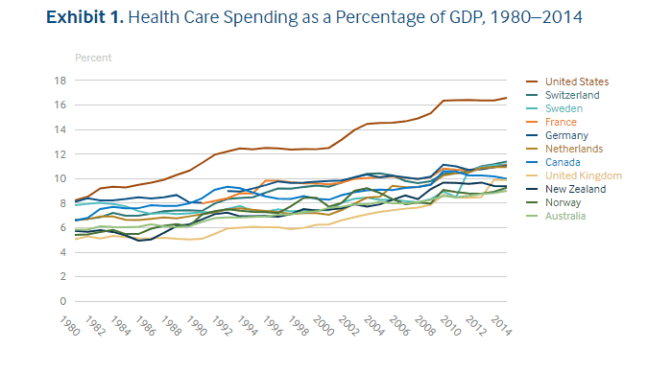What is wrong with US healthcare system?
The United States has a long and winding road of attempts to create national healthcare coverage. For over one hundred years, Presidential administrations have struggled to meet the demands of public interest and private influence in order to provide what would be considered “American” healthcare – that which is available to all but not necessarily run by the government. Meeting the needs of conflicting interests has not been successful.
Medicare and Medicaid only met the needs of a portion of the population. It would take the Patient Protection and Affordable Care Act – also known as the Affordable Care Act – better known as Obamacare – to pass in 2010 to cover the entire nation. Now it is potentially being stripped of its capability. Let’s take a look at what US healthcare grades look like going into 2018.
Paying big bills
Given the backdrop of other developed countries, the US spends more with an uneven return on investment. According to The Commonwealth Fund report, 11 high-income countries share a challenge of rising healthcare costs as a measure of the percentage of GDP. Canada seems alone in any curbing of inflation. The US though stands suspiciously alone as the leader in spending. [1]

Image courtesy of The Commonwealth Fund
What does the data look like? In 2015 the US spent $3.2 billion for healthcare, at 17.8% of GDP. In 1960, those numbers were $27.2 million, which was a slim 5% of GDP[2]. Costs aren’t tagged to specific functions either. The spectrum of doctor’s visits, hospital stays and drugs all contribute to the bottom line. There’s no smoking gun that accounts for the cost inequity.
To make matters worse, low inflation in recent years of recession has kept costs contained to some degree as well. That effect, in combination with fluctuations in administrative Medicaid payments, is likely to wear off and the US could see a further soar in costs, extrapolating the negative lead.
| Recommended for you | |
| Understanding the US healthcare system | |
| The Digital Health Society Declaration by the EU | |
| How to raise funding for your digital health startup in the US? |
Less return on investment
The same Commonwealth Fund report also measured healthcare performance. The US again slides to the end of the spectrum against comparable countries. Not only are US citizens paying more, they do not necessarily get better performance.
“The United States fared especially badly on measures of affordability, access, health outcomes, and equality between the rich and poor.” [3]

Image courtesy of The Commonwealth Fund
The US continues to lag behind other high-income countries as it struggles with comprehensive healthcare issues. US patients are more likely to receive unneeded tests and treatments. The trip to the doctor’s office or the emergency room is likely to include a suite of procedures that cover malpractice potential more so than enhance the patient’s recovery.
Medical errors are also a concern. These range from wrong procedures to excessive prescriptions to surgery catastrophes. In 2016, NBC News reported that these mistakes if considered a “cause of death” would be the third largest killer from the classic cancer and heart disease. [4]

The year ahead
In 2018, the healthcare issue will continue to plague the US and the current administration. By means of the tax reform act signed in late December, the individual mandate penalty required by Obamacare will expire in 2019. President Trump – without Congressional input – can cut the subsidies which have partially been keeping Obamacare in play. He can also cut the marketing and Public Announcement campaigns for signing up citizens for the program, causing a decrease in enrollments and further threatening Obamacare implosion.
Several other items are also being considered. With the recent success under their belt, Republicans in Congress are also looking to take aim at reforming Medicare and Medicaid.
Potentially they would update its operations to include premiums and take on a more competitive stance. Also the Children’s Health Insurance Program (CHIP) has the rare opportunity of bipartisan support; however, everything comes with a price and it will have to survive the competitive interest field.
In that thread, another vying concern is over an “opioid crisis”. Its price tag is derived for curbing over-prescription as well as among other needed countermeasures.
Any good news?
Of course! What all this does mean is continued and expanded expenditure in the healthcare industry. First, that means jobs, jobs, jobs. People are needed for research, for education, for care and for the paperwork to make the whole thing move forward.
Secondly, it means that healthcare continues to be a source of spending. Funding and resources will continue to suck into this huge industry that has demonstrated sustained growth proportionate to the Gross Domestic Product.
Finally, for the entrepreneurs, this dysfunction can be seen as an opportunity. With many weak links and fat purses, there’s lots of room for improvement which mean new businesses.
As outlined in the history of US healthcare, a single beacon of hope from the government is not likely to appear. What is needed is some smart people and smart companies to make US healthcare affordable, available and effective.
Image credit: www.pixabay.com


















Helpful, thank you